If you see a black and yellow buoy or post when you’re sailing, do not ignore it. These types of marker are called cardinal marks, and help you to avoid hidden dangers in the water.
Black and yellow, with a flashing white light, cardinal marks show you how to safely navigate around an underwater hazard. Cardinal marks come in the form of buoys or posts, with four varieties, one for each of the cardinal points on the compass.
Cardinal marks are positioned to show the extent of any submerged hazard.
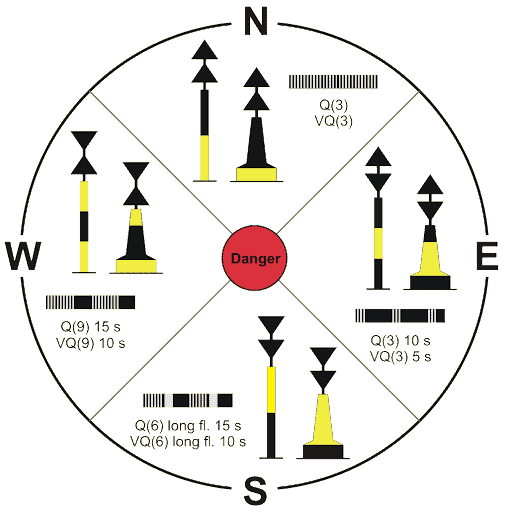
How to Identify Cardinal Marks
Each of the four types of cardinal mark, North, South, East and West, can be identified in three different ways:
- The layout of the back and yellow markings
- The orientation of top mark (cones on top of the cardinal mark)
- The light characteristics of the mark (the pattern of the flashes)
Unlike other types of maritime buoyage, cardinal marks are consistent across both the IALA A and B buoyage systems.
This thankfully means that you can rely on cardinal marks to have exactly the same meaning, wherever in the world you see them!
Once you know what type of cardinal mark you’re looking at (North, South, East or West), you will immediately know how you need to navigate around it to stay in safe water.
For example: If you’re sailing towards a south cardinal mark, you must pass to the south of the south cardinal mark, so as to avoid the hazard.
North Cardinal Marks
North cardinal marks indicate the northern most extent of a hazard in the water. You must pass to the north of a north cardinal mark to remain in safe water.
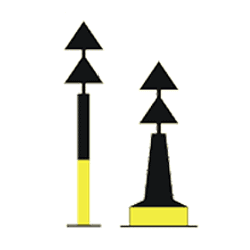
Colour Layout: Black over Yellow
Top Marks: Two cones pointing up
Light Characteristics: White light. Quick (or very quick) continuous flashes
South Cardinal Marks
South cardinal marks indicate the southern most extent of a hazard in the water. You must pass to the south of a south cardinal mark to remain in safe water.
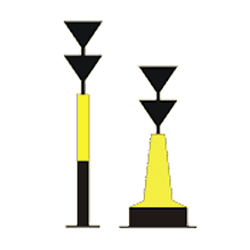
Colour Layout: Yellow over Black
Top Marks: Two cones pointing down
Light Characteristics: White light. 6 quick flashes and 1 long flash, every 15 seconds (or 6 very quick flashes and 1 long flash, every 10 seconds).
East Cardinal Marks
East cardinal marks indicate the eastern most extent of a hazard in the water. You must pass to the east of a east cardinal mark to remain in safe water.
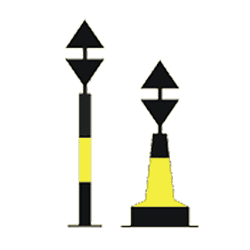
Colour Layout: Black, Yellow, Black
Top Marks: Two cones pointing away from each other
Light Characteristics: White light. 3 quick flashes, every 15 seconds (or 3 very quick flashes, every 5 seconds).
West Cardinal Marks
West cardinal marks indicate the western most extent of a hazard in the water. You must pass to the west of a west cardinal mark to remain in safe water.
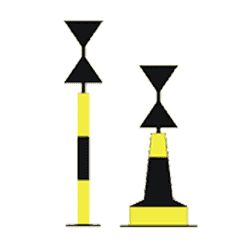
Colour Layout: Yellow, Black, Yellow
Top Marks: Two cones towards each other
Light Characteristics: White light. 9 quick flashes, every 15 seconds (or 9 very quick flashes, every 10 seconds).
Easy Tips to Identify Cardinal Marks
There are a few simple tricks you can use to easily identify a cardinal mark both in the day time and at night. This is how I like to remember it…
Clock Face Trick for Cardinal Mark Light Characteristics
Picture the North, East, South and West points on a compass. Then equate them to numbers on a clock.
- East would be 3 o’clock
- South would be 6 o’clock
- West would be 9 o’clock
Each of the East, South and West cardinal marks have light characteristics which match their position on the clock face.
An East Cardinal Mark has 3 quick light flashes, South has 6 quick flashes (and one long flash), and West has 9 quick flashes.
If you can picture a clock face, you can identify 3 of the 4 cardinal marks. Then it’s just a process of elimination to get North!
Easter Egg Trick to Identify Cardinal Mark Top Marks
When it comes to the cones on top of a cardinal mark, the North and South Cardinal Mark characteristics are pretty obvious. Both cones point to the relevant point on the compass!
However, I always used to struggle to remember the top mark cones orientation for East and West Cardinal Marks.
That was until somebody pointed out to me that the East Cardinal Mark cones look like an easter egg!
Remember that tip, and you can then use a process of elimination to identify a West Cardinal Mark.
In fact, did you notice that the way the cones point actually correlate to where the black section of the cardinal mark is?
The top of a North Cardinal Mark is black, and both cones point up.
The bottom of a South Cardinal Mark is black, and both cones point down.
The top and bottom of an East Cardinal Mark are both black, with a yellow stripe between, and the cones point top and bottom.
The middle of a West Cardinal Mark is black, with a yellow top and bottom, and the cones point inwards towards one another.
Coincidence? I think not!
In fact, it’s actually a really helpful feature. If the mark is covered in filth, you can at least still identify the type of cardinal mark you’re looking at, just from the top mark.
Cardinal Marks Explained
Thanks to the guys at Casual Navigation for putting together this excellent video to further explain the purpose of cardinal marks…
